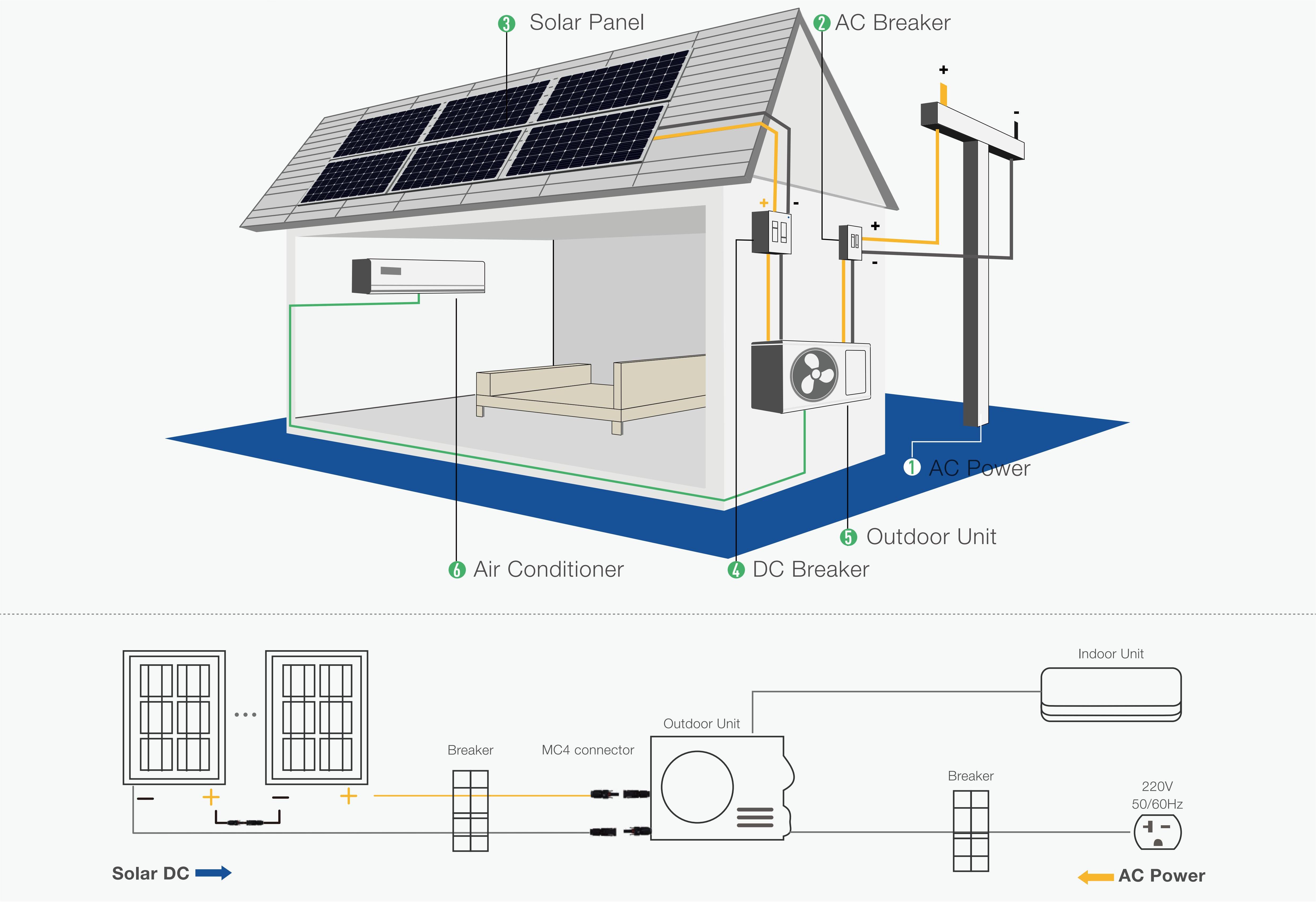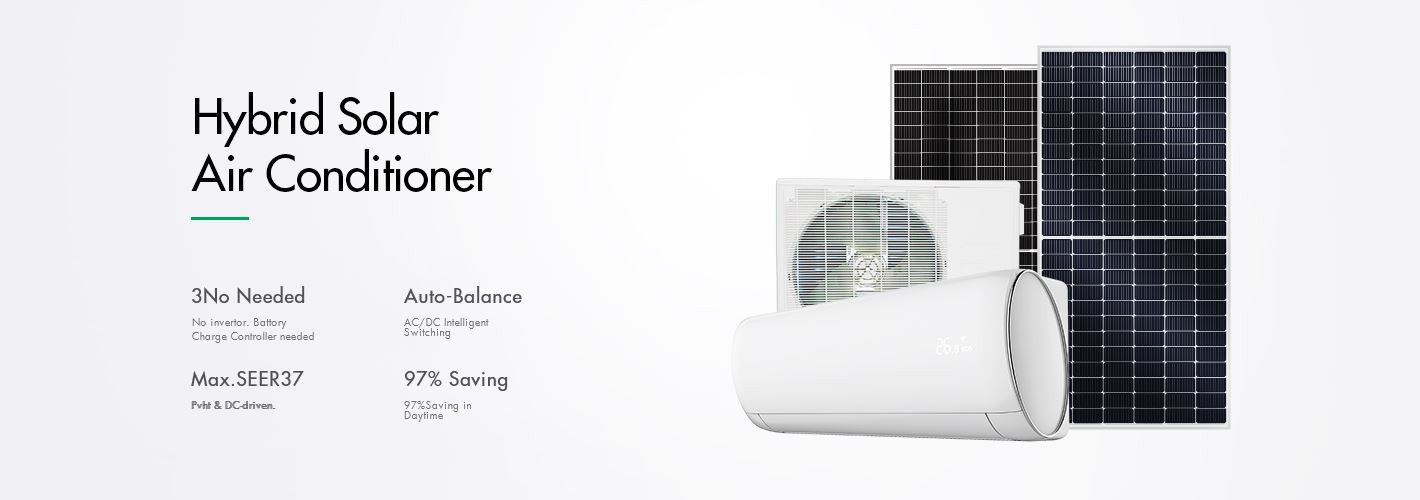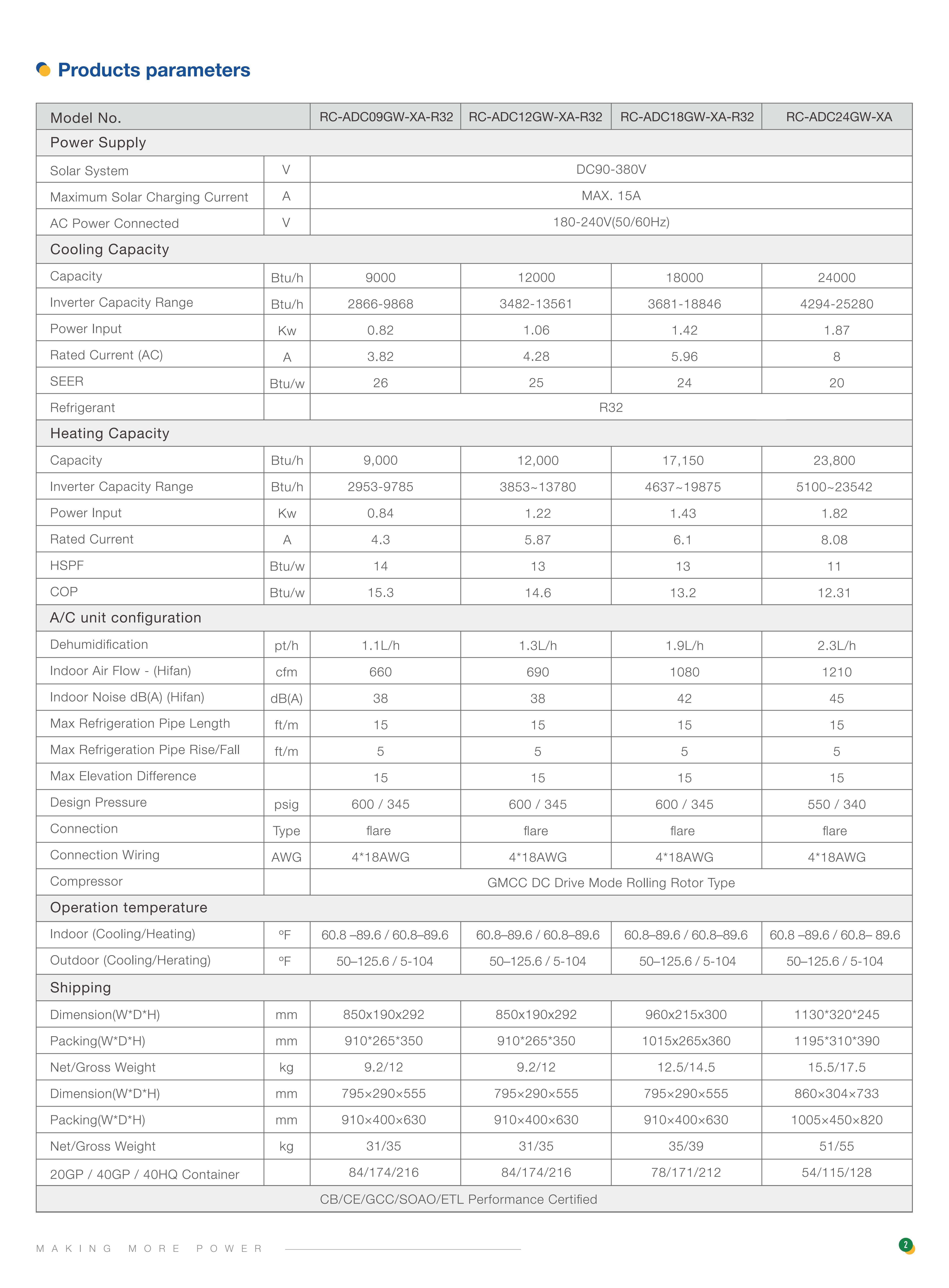A solar-powered air conditioner operates using energy generated from solar panels or solar collectors. The components inside a solar-powered air conditioner are similar to those found in a conventional air conditioner but with the addition of a solar power system.
Solar panel voltage:
DC90-380VMaximum Solar Charging Current:
15AAC Power Connected:
180-240V(50/60Hz)Refrigerant:
R32Compressor:
GMCC DC Drive Mode Rolling Rotor TypeConnection:
Flare
Here are the key components typically found in a solar air conditioner:
Solar Panels: These are the primary component that harnesses sunlight and converts it into electricity. Solar panels consist of multiple photovoltaic cells that generate direct current (DC) electricity when exposed to sunlight.
Solar Charge Controller: The solar charge controller regulates the incoming power from the solar panels and ensures that the energy is efficiently stored in the system's batteries. It prevents overcharging and helps optimize the performance of the solar air conditioner.
Batteries: The solar power system includes batteries to store the excess energy generated by the solar panels. These batteries store the electricity and provide a continuous power supply to the air conditioner, even during periods of low solar radiation or at night when the sun is not available.
Inverter: The DC power stored in the batteries is converted into alternating current (AC) power using an inverter. This AC power is then used to operate the air conditioning system.
Air Conditioning System: The air conditioning system consists of components such as the compressor, condenser, evaporator, expansion valve, and fans. These components work together to cool and dehumidify the indoor air. The compressor, which consumes the most electricity, is powered by the solar-generated electricity provided by the batteries and inverter.
Control System: The control system manages the operation of the solar air conditioner. It regulates temperature settings, fan speed, and controls the overall performance of the system. It also monitors the power supply from the solar panels and battery status.
Overall, a solar-powered air conditioner combines the components of a traditional air conditioning system with a solar power system to reduce reliance on the electrical grid and minimize the environmental impact by utilizing renewable energy sources.

The exact components and specifications may vary depending on the manufacturer and model, but here are the basic components commonly found in solar air conditioners:
Solar Panels: Solar air conditioners are equipped with photovoltaic (PV) solar panels that convert sunlight into electricity. These panels are typically mounted on the roof or in a location where they can receive maximum sunlight exposure.
Batteries (Optional): Some solar air conditioners may include battery storage systems to store excess solar energy generated during the day. These batteries can be used to power the air conditioner during periods of low sunlight or at night.
Compressor: The compressor is the main component responsible for circulating the refrigerant and compressing it to create cooling effect. It requires electricity to function, which is supplied by the solar panels or batteries.
Evaporator and Condenser Coils: These coils are part of the refrigeration cycle in the air conditioner. The evaporator coil absorbs heat from the indoor air, while the condenser coil releases the heat outside. The refrigerant flowing through these coils facilitates the heat transfer process.
Expansion Valve: The expansion valve controls the flow of the refrigerant into the evaporator coil, allowing it to expand and absorb heat from the indoor air.
Controller/Inverter: Solar air conditioners are equipped with a controller or inverter that regulates the flow of electricity from the solar panels or batteries to the compressor. It ensures the air conditioner operates efficiently and optimizes the use of available solar power.
Regarding the performance of solar air conditioners in bad weather, it largely depends on the system design and the amount of sunlight available. Solar air conditioners can operate on cloudy days, but their efficiency and cooling capacity may be reduced compared to sunny days when more solar energy is available. Some systems may also incorporate battery storage to provide power during periods of low sunlight. It's important to consider the climate and local weather conditions when deciding to install a solar air conditioner and to consult with the manufacturer for specific details on its performance under different weather conditions.

The cooling principle of an air conditioner involves the process of refrigeration. Here's a brief explanation of how it works:
Evaporator: The air conditioner's evaporator coil is located inside the indoor unit. It contains a refrigerant, which is a substance that can easily change between liquid and gaseous states at low temperatures. The evaporator coil is responsible for absorbing heat from the indoor air.
Refrigerant circulation: The refrigerant, typically a chemical compound such as hydrofluorocarbon (HFC), enters the evaporator coil as a low-pressure liquid. As warm air from the room is blown over the coil, the refrigerant absorbs the heat, causing it to evaporate into a gas.
Compressor: The compressor, located in the outdoor unit of an air conditioner, plays a crucial role in the cooling process. It raises the pressure and temperature of the refrigerant gas, compressing it into a high-pressure, high-temperature state.
Condenser: The high-pressure refrigerant gas flows into the condenser coil, located in the outdoor unit, where it releases heat to the surrounding environment. As the refrigerant cools down and condenses, it changes back into a high-pressure liquid.
Expansion valve: The high-pressure liquid refrigerant then passes through an expansion valve, which reduces its pressure and temperature. This process prepares the refrigerant to repeat the cycle by entering the evaporator coil again.
This continuous refrigeration cycle enables an air conditioner to extract heat from indoor air, expel it outdoors, and maintain a cooler indoor temperature.
In the case of a solar-powered air conditioner, the cooling principle remains the same. However, instead of relying solely on electricity from the grid, it utilizes energy from solar panels to power the components involved in the refrigeration cycle. Solar panels convert sunlight into electrical energy, which can be used to run the air conditioner, including the compressor and other electrical components.
FAQs:
Q1: Do you support OEM/ODM?
A:Definitely, OEM&ODM service is supported with a certain quantity,including customize logo,package and label;
Q2: What's the production time?
A: The production time is normally 15 working days. but we will always prepare some stocks for popular models.
Q3: Can you provide DDP service?
A:Yes, if you are a personal customer and don't want to deal with the customs, we can provide DDP service to your address.
Q4: What about the warranty and how to claim?
A: Warranty period are 5 years since you receive the product, our professional after-sales team will deal with all warranty issues.